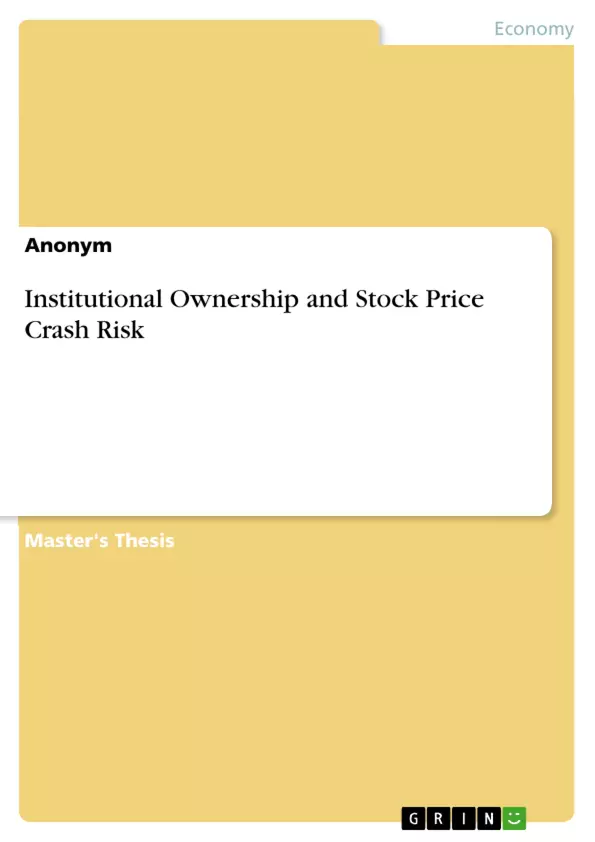This study uses OLS regressions to analyze the impact of institutional ownership (IO) investment horizons on stock price synchronicity and crash risk for a sample of U.S. companies. Two main hypotheses are tested:
(1) long-term (short-term) IO (LTIO) (STIO) are negatively (positively) related to stock price synchronicity, and
(2) long-term (short-term) IO are negatively (positively) related stock price crash risk.
Stock price synchronicity (SYNCH) measures how much firm-specific returns align with overall market returns, while crash risk (NCSKEW, DUVOL, COUNT) indicates the likelihood of a sudden, significant price drop. The theory posits that short-term investors, more prone to sell shares, provide weaker oversight, giving managers more freedom to influence cash flows and increasing synchronicity. In contrast, long-term investors establish stronger management relationships, reducing synchronicity through enhanced oversight.
The findings reveal that both long-term and short-term IO positively impact synchronicity, contradicting the hypothesis for long-term IO. This aligns with literature suggesting institutional investors use superior information mainly for trading rather than management engagement.
For crash risk, results support the agency theory: long-term IO is associated with reduced crash risk due to better monitoring, while short-term IO correlates with higher crash risk due to frequent trading and weaker oversight. These findings align with prior research, indicating that bad news is disclosed under long-term monitoring, causing abrupt price drops.
During the 2008 financial crisis, average crash risk was significantly higher, especially for financial firms. The interaction between IO horizons and the crisis suggests complex dynamics needing further study, particularly the negative interaction of long-term and aggregated IO during recessions.
Robustness checks, including firm fixed-effects regressions and variable changes, confirm primary findings but suggest cautious interpretation for long-term IO results. Limitations include a relatively short observation period (2000-2017), potential measurement biases in tax avoidance proxies (long-run cash effective tax rate (LRETR)), and unaddressed endogeneity concerns.
Future research should explore evolving ownership structures, corporate social responsibility, and impacts of recent disruptions like the COVID-19 pandemic on crash risk.
Inhaltsverzeichnis (Table of Contents)
- Introduction
- Literature review
- The principal-agent theory
- Institutional investors
- Stock price synchronicity
- Stock price crash risk
- Data and methodology
- Sample description
- Variables and proxies
- Regression design and approach
- Regression results
- Analyzing holding levels and trading of institutional investors
- Institutional ownership and crash risk
- Institutional ownership and crash risk during the financial crisis
- Robustness checks
- Conclusion
Zielsetzung und Themenschwerpunkte (Objectives and Key Themes)
This work aims to investigate the relationship between institutional investor activities and stock price crash risk. It analyzes how different types of institutional investors influence corporate governance and risk management, ultimately impacting the probability of stock price crashes. The study examines the role of institutional ownership and trading in mitigating or exacerbating crash risk, considering both long-term and short-term investors.
- The role of institutional investors in corporate governance and risk management.
- The influence of institutional ownership and trading on stock price crash risk.
- The impact of different types of institutional investors (long-term vs. short-term) on crash risk.
- The potential for institutional investors to mitigate or exacerbate crash risk.
- The implications of these findings for corporate governance and investor behavior.
Zusammenfassung der Kapitel (Chapter Summaries)
- Introduction: The chapter introduces the concept of stock price crashes, their causes, and the growing body of research on this topic. It highlights the importance of corporate governance and the role of institutional investors in mitigating crash risk.
- Literature review: This chapter reviews existing theories and empirical evidence related to institutional investor behavior, stock price synchronicity, and crash risk. It examines the principal-agent theory and discusses the different types of institutional investors and their motivations.
- Data and methodology: The chapter outlines the data sources, sample description, and methodologies used in the study. It explains the variables and proxies employed to measure institutional ownership, trading activity, and crash risk.
- Regression results: This chapter presents the results of the regression analysis, exploring the relationship between institutional ownership and trading and the probability of stock price crashes. It examines the impact of different types of institutional investors and analyzes the findings in the context of the global financial crisis.
Schlüsselwörter (Keywords)
The study focuses on the relationship between institutional investor activities, corporate governance, and stock price crash risk. Key concepts include institutional ownership, institutional trading, stock price synchronicity, crash risk, principal-agent theory, and the global financial crisis. The analysis examines the impact of different types of institutional investors (long-term vs. short-term) and explores the potential for institutional investors to mitigate or exacerbate crash risk.
- Citar trabajo
- Anonym (Autor), 2024, Institutional Ownership and Stock Price Crash Risk, Múnich, GRIN Verlag, https://www.grin.com/document/1477247



